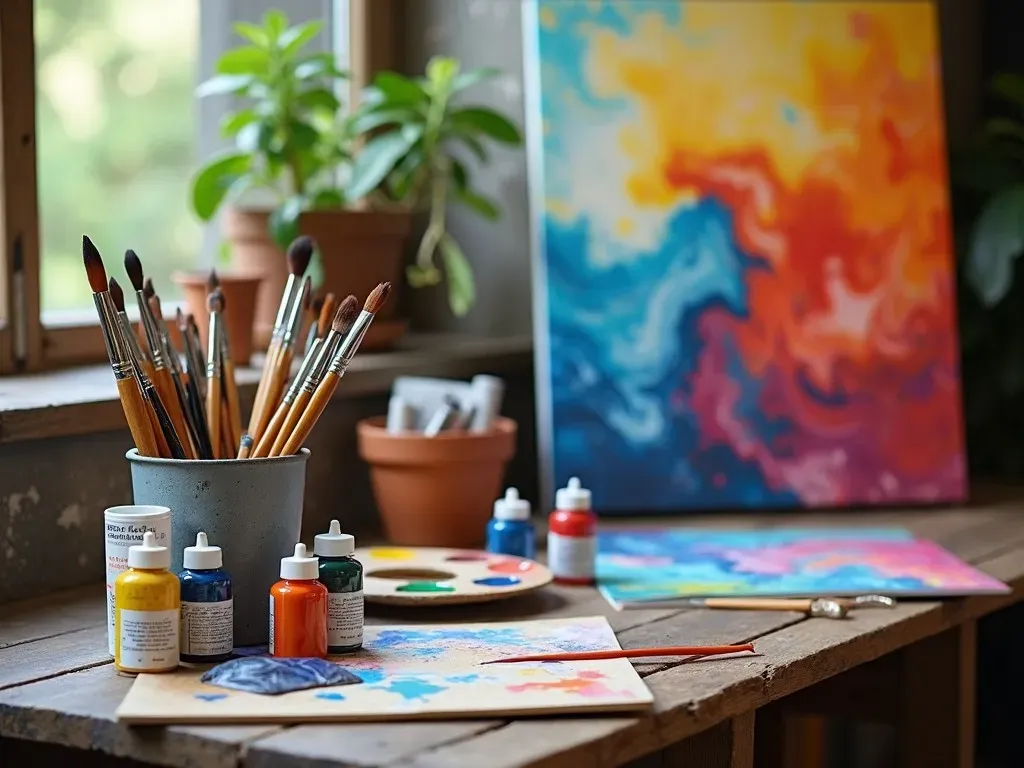An oil paint set is a comprehensive collection of oil painting supplies designed for artists at every skill level—from beginners to seasoned professionals. This essential toolkit not only includes high-quality oil paints but often comes with brushes, palettes, and even canvases, tailored to suit various painting styles and preferences.
Let’s dive deeper into the world of oil paint sets and find the perfect one for your artistic journey.
What to Look for in an Oil Paint Set
When selecting an oil paint set, consider the following elements that might influence your painting experience:
Quality of Paint
- Pigment Strength: High-quality sets contain pigments that provide better color saturation and luminosity. Look for oil paints that are labeled as “professional” or “artist-grade” for superior performance.
- Consistency: The texture of the paint should allow for smooth application. Creamy or buttery oil paints usually spread better, allowing for smoother blends and layering.
Composition
Oil paints are derived from various oils, the most common being linseed oil. Non-toxic formulations are also available, especially important if the paint is intended for use by children.
Set Size
Choosing the right size is crucial. Here’s a simple breakdown:
| Set Size | Ideal For |
|---|---|
| 3-6 colors | Beginners or hobbyists, experimenting with color mixing. |
| 12-24 colors | Intermediate artists who want a broader palette. |
| 30+ colors | Professionals who need a vast array of options. |
Accessories Included
Many oil paint sets come with useful accessories such as brushes, palettes, or canvas boards. Here’s a sample list of common inclusions:
- Brushes of various sizes
- Mixing palette
- Canvas or canvas boards
- Palette knives
- Mediums (like linseed oil or turpentine)
Best Oil Paint Sets for Beginners
Oil painting can seem intimidating at first, but the right oil paint set can ease the entry into this rewarding art form. Here are a few recommendations:
-
Ohuhu Oil Paint Set
- Contents: 24 oil-based colors, 12ml tubes
- Price: Approximately $16.99
- Ideal for: Beginners, students, and kids
-
Paul Rubens Oil Painting Set
- Contents: 20 premium colors, 50ml tubes
- Price: Approximately $51.99
- Ideal for: Beginners to intermediate artists
-
MyArtscape Oil Paint Set
- Contents: 24 colors, 12ml tubes
- Price: Approximately $29.99
- Ideal for: Artists of all levels looking for archival quality.
Specialty Oil Paint Sets
For those interested in specific themes or effects in their art, consider these specialized oil paint sets:
-
Water Mixable Oil Paints: These allow for easy clean-up with water instead of solvents. Options like Winsor & Newton Artisan are popular.
-
Metallic Oil Paint Sets: Ideal for adding a shimmer effect to artwork, these are designed for artists interested in adding a unique touch.
Reference Video
Essential Painting Techniques with Oil Paint
Once you have your oil paint set, understanding a few Techniques can elevate your paintings:
Glazing
This involves applying thin layers of transparent paint over a dry base layer to create depth and luminosity.
Impasto
Thick layers of paint create textured effects. This technique requires heavy-bodied paints that retain their form.
Blending
Oil paints blend well when wet, permitting a smoother color transition. Exploring this technique can lead to stunning gradients in your artwork.
Care and Maintenance of Your Oil Paint Set
Maintaining your oil paint setup ensures longevity and quality performance. Here are some care tips:
Brushes
- Clean brushes thoroughly with solvents like mineral spirits.
- Reshape the bristles after cleaning to avoid damage.
Paint Storage
- Keep tubes capped and in a cool, dry place.
- Avoid direct sunlight, which can alter the color of the pigments.
Palette
- Using a glass or acrylic palette makes cleaning easier.
- Scrape off dried paint but avoid using metal tools that can scratch the surface.
Frequently Asked Questions (FAQ)
Q: How long do oil paints take to dry?
A: Oil paints can take anywhere from several days to weeks to fully dry, depending on the thickness of the application and environmental conditions.
Q: What is the difference between student-grade and artist-grade oil paints?
A: Artist-grade oil paints contain higher concentrations of pigment and offer better color performance, while student-grade paints are less expensive and often have fillers.
Q: Can oil paints be mixed with acrylics?
A: It is generally advisable to avoid mixing oil and acrylic paints as they have different drying processes, which can lead to undesirable results.
Q: What is the best way to thin oil paint?
A: Linseed oil or turpentine can be used to thin oil paint. They allow for easier application and improved flow.
Q: Are there any non-toxic oil paint options?
A: Yes, many brands offer non-toxic oil paint sets, making them safer for children and those with sensitivities.
For further exploration and options, you can check out BLICK Art Materials for a wide range of oil paint sets and Supplies.
By understanding and selecting the right oil paint set tailored to your needs, you’re well on your way to developing your skills and exploring the fabulous world of oil painting!
